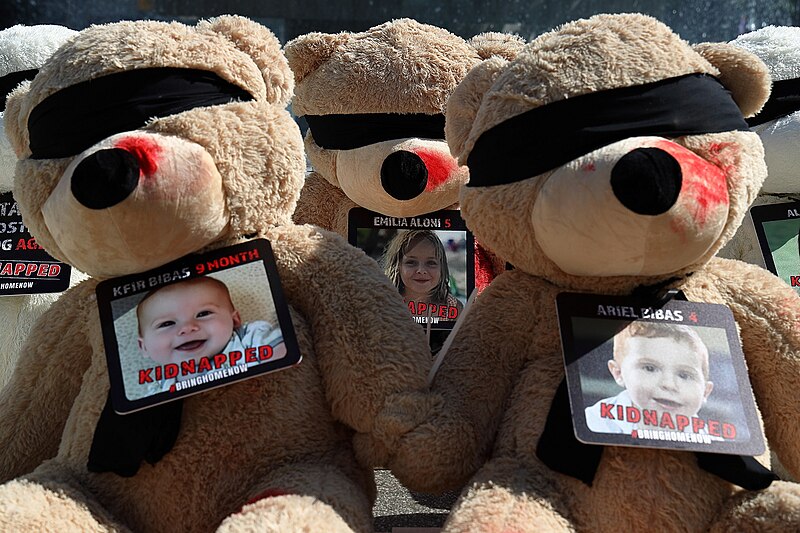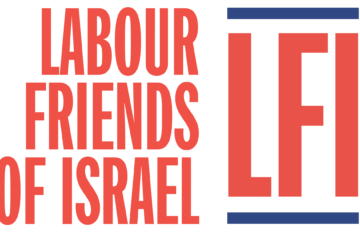
Kidnapped teddy bears performance – Dizengoff Square. Source: Lizzy Shaanan Pikiwiki Israel, CC BY 2.5 DEED, via Wikimedia Commons.
Hostage deal
- On 21 November, the Israeli cabinet approved a deal to secure the release of at least 50 Israeli civilian hostages, beginning with women and children. Those released are expected to include 30 children, eight mothers and twelve elderly women. Around 240 hostages are being held in total.
- According to an Israeli government statement, “at least 50 abductees – women and children – will be released over 4 days, during which there will be a lull in the fighting. The release of every ten additional abductees will result in an additional day of respite.”
- In return, Israel will release 3 Palestinian prisoners for every Israeli released. These will primarily be minors and women, many of them arrested in the West Bank for violent offences including a stabbing attack, rock throwing and rioting. Israel has provided a list of 300 people who could potentially be released. In addition, hundreds of trucks with humanitarian aid, medical aid and fuel are expected enter the Gaza Strip during the lull.
- The deal is expected to go into effect on Thursday morning, after the Israeli High Court hears an appeal by an Israeli terror victims association against the release of the Palestinian prisoners. The judges are expected to reject the appeal.
- Prime Minister Netanyahu confirmed that, as part of the deal, International Red Cross officials would be visiting the remaining hostages.
- On 2 November, Palestinian Islamic Jihad (PIJ) announced the death of one of the Israeli hostages, Hannah Katzir, a 77 year old woman from Kibbutz Nir Oz.
Situation in the Gaza Strip
- IDF operations to clear Hamas out of the northern Gaza Strip, including areas of Gaza City and Jabalya, have continued, along with airstrikes on targets across the Gaza Srip. The IDF has continued to urge civilians to leave the area and provided safe corridors for several hours each day, and medical agencies are completing the evacuation of final patients from Al Shifa hospital. As of 21 November, Israel has lost 66 soldiers killed inside the Gaza Strip. Sporadic rocket fire at Israeli towns and cities continues from the southern Gaza Strip and hundreds of thousands of Israelis remain displaced from communities on Gaza and Lebanon borders.
- The IDF has continued to produce evidence of the use of Al Shifa Hospital by Hamas for military purposes. On 21 November, the IDF breached a blast door at the end of a Hamas tunnel underneath the hospital. It has also released footage from hospital CCTV showing hostages being bought into the hospital by armed men on October 7, and Hamas and stolen IDF vehicles being brought into the hospital grounds. The bodies of two Israeli hostages have been discovered next to the hospital grounds. Last week the IDF showed journalists a basement of Rantisi hospital with weapons and evidence that hostages had been held there.
- Since 18 November, Israel has been allowing the entry of fuel for UNRWA to distribute for critical services including food distribution, and the operation of generators at hospitals, water and sanitation facilities, and shelters. On 21 November, 63,800 litres of fuel entered from Egypt. Evacuations of critical medical cases to Egypt is continuing, including 29 premature babies evacuated from the Shifa hospital by the IDF. A first Jordanian field hospital also entered the Strip.
- Gaza’s health ministry, which is run by Hamas, now claims that more than 14,000 Gazans have died since the start of the operation. These figures cannot be independently verified, and include both civilians and Hamas members killed, and those killed by misfiring rockets from within the Gaza Strip.
Northern border and Red Sea
- Israel continues to come under daily fire from rocket and anti-tank missile fire from Hezbollah and Palestinian groups in south Lebanon, with a steady escalation in the scope of activity and types of weaponry used. The IDF continued to respond with fire to the source of the attacks, including four Hamas terrorists killed in an Israeli drone strike in southern Lebanon on 21 November.
- For now, both sides are keeping the intensity of the exchanges below a certain threshold. Israel’s current approach is to contain the threats on the northern front and focus on Gaza, but calls are growing to confront the Hezbollah threat directly, and the risk of intended or unintended escalation on either side is high.
- Houthi fighters seized a cargo ship ‘Galaxy Leader’ in the southern Red Sea on 19 November, following threats to attack Israeli shipping. Israel denied the ship was Israeli. According to Times of Israel, the Bahaman-flagged vessel is registered under a British company, which is partially owned by Israeli tycoon Abraham ‘Rami’ Ungar. The vessel was leased out to a Japanese company at the time of the hijacking.
In the UK
- Shadow Foreign Secretary David Lammy visited Jerusalem, Tel Aviv and Ramallah on 20 November. Lammy met with Israel’s President Isaac Herzog, Foreign Minister Eli Cohen, Leader of the Opposition Yair Lapid as well as Leader of the Israeli Labour Party Merav Michaeli.
- In a statement, Lammy said: “The international community, including successive Conservative governments, must learn the lessons of decades of failure to resolve this conflict. For too long, our leaders have been content with the delusions of wishful thinking when it comes to peace in the Middle East. There has been a failure to deliver the two-state solution that is necessary to deliver long-term peace, security and independence to both Israel and Palestine”.
- The statement continued: “Labour is realistic about Britain’s influence in the region but knows its historic responsibilities. The next Labour government will be tirelessly committed to playing its role in the hard diplomacy required with Israel, Palestine, partners in the Gulf and the wider Middle East region to help deliver a real, not rhetorical, path to two-state solution.”
- LFI Director, Michael Rubin, stated that “it’s hugely important that David Lammy has made his second visit to Israel as shadow foreign secretary. We share his emphasis on the need to support Israel after the atrocities of 7 October and address the humanitarian emergency in Gaza. As Keir Starmer and David Lammy have both said, a permanent solution to the conflict will require a laser-like focus by the international community on promoting two states for two peoples and ensuring Israel’s security.”
- After a series of local pro-Palestinian marches on 18 November, a ‘National Mach for Palestine’ has been called for central London on 25 November. Previous marches have seen antisemitic slogans and signs, as well as clashes with police among a small minority of protestors.
- From 7 October to 15 November, CST recorded at least 1324 antisemitic incidents across the UK, the highest ever total recorded. Many involved verbal abuse, but also include 64 assaults, 92 cases of damage and desecration of Jewish property, and 120 direct threats.
President Biden’s blueprint for a renewed peace process
- In an op ed in the Washington Post on 18 November, President Biden set out a blueprint for bringing peace to the Israeli-Palestinian arena and the wide region. Biden’s expressed his belief that Hamas instigated the crisis to disrupt proposals for regional integration including “the innovative economic corridor that will connect India to Europe through the United Arab Emirates, Saudi Arabia, Jordan and Israel, which I announced together with partners at the Group of 20 summit in India in early September.”
- Other key points in his article include:
- “We stand firmly with the Israeli people as they defend themselves against the murderous nihilism of Hamas.”
- “There must be no forcible displacement of Palestinians from Gaza, no reoccupation, no siege or blockade, and no reduction in territory. And after this war is over, the voices of Palestinian people and their aspirations must be at the center of post-crisis governance in Gaza.”
- “Gaza and the West Bank should be reunited under a single governance structure, ultimately under a revitalized Palestinian Authority, as we all work toward a two-state solution.”
- “The international community must commit resources to support the people of Gaza in the immediate aftermath of this crisis, including interim security measures, and establish a reconstruction mechanism to sustainably meet Gaza’s long-term needs.”
- “An outcome that leaves Hamas in control of Gaza would once more perpetuate its hate and deny Palestinian civilians the chance to build something better for themselves”.
The coming days
- The hostage deal changes the pattern of events substantially and creates a delicate and uncertain period for the coming days. The duration of the pause in fighting now depends on the successful implementation of a complex agreement. If the implementation of the first phase is successful, pressure will be high from hostage families to continue the process and secure the return of as many captives as possible. However successful this current deal is, a significant number of hostages will remain in Hamas hands.
- The Israeli government remains adamant that there is no change in its goal of destroying Hamas, and the IDF will use the lull to plan the next stage of its operations. Whilst Israel has dismantled much of Hamas’s infrastructure in the northern Gaza Strip it has yet to fully enter the Jabalya and Shejaiya areas adjacent to Gaza City. Meanwhile the greater portion of Hamas’s fighting capabilities and its top leadership are believed to remain intact in the southern Gaza Strip. Tackling the south will entail new challenges since this is where Gaza’s population has now been concentrated. Hamas will use the lull in fighting to regroup and prepare for renewed fighting.


